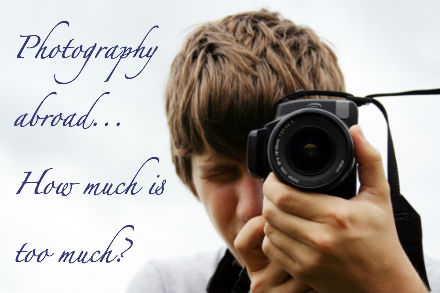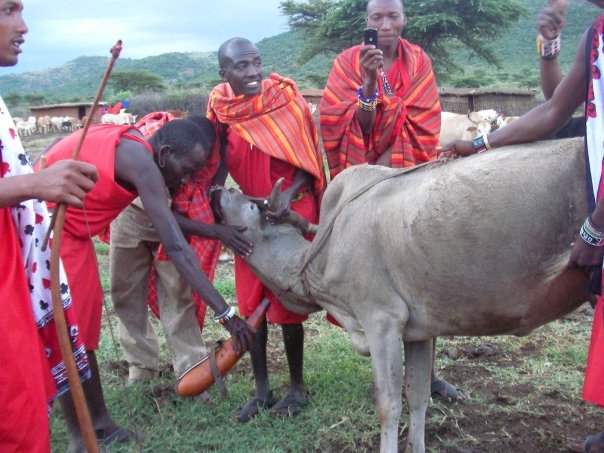 While taking U.S. university students on short-term cultural immersion programs in Morocco, I heard the following on a regular basis:
While taking U.S. university students on short-term cultural immersion programs in Morocco, I heard the following on a regular basis:
“Oh my God, this is so going to be my profile picture!”
“Pics or it didn’t happen!”
“I didn’t get a picture of that… we HAVE to go back!
With the changing technology and popularity of digital cameras, Facebook, and blogs, it has never been easier to take, edit, and share pictures. Photographs can be an incredible way of capturing moments abroad. It’s an easy way to share what you are doing with people back home, and a great way to look back and remember amazing moments.
But how much is too much? At what point can taking pictures while studying abroad go from being a great tool to a destructive obsession?
Some instances are very clearly inappropriate instances to take pictures. Taking a candid shot of a stranger without asking is a relatively obvious faux pas. Even if you think they don’t mind, always check beforehand. In some cultures, there are beliefs that taking someone’s photograph is equivalent to taking their soul, violating their modesty, or an invitation for the evil eye to affect them. In these situations, it goes beyond impolite to snap away without permission: it can actually be quite offensive and even perceived as assault.

It is disturbingly common for people to use the “secret surreptitious photograph” style: wait until the intended subject of the photo isn’t looking, then taking the picture in secret in order to get an unposed, “authentic” shot. By doing this, a photographer can get the image they want and get around the need to ask permission. However, when looking back at that image, is it really worth it? Is the image really a fun, happy, or interesting memory, or will it evoke the guilt of taking the picture without permission? Going deeper—what does the picture mean? What is the purpose of taking this kind of photograph?
Excessive picture-taking can be an insult or worse to people of the host culture, and many may perceive you as an annoying and disruptive tourist. However, in actuality, becoming a slave to one’s camera probably has the biggest impact on the photographers themselves.
Take, for example, the extreme disappointment that happens when someone didn’t have enough time to take a picture, the battery died, or his or her camera was broken or stolen. I have seen instances where this has literally ruined peoples’ days or longer. In that moment, instead of really engaging and experiencing being somewhere new and exciting, all the energy is focused on the negativity of missing out and anger or disappointment.
On the same level, I’ve seen many people stress out about getting the “perfect” picture. Instead of enjoying the view of the sunset over Notre Dame Cathedral, time is spent adjusting, taking pictures, looking for a good angle, and taking the picture again. The best advice I had right before leaving the US for the first time was not to worry too much about pictures of monuments or places; skilled photographers with better equipment and experience have made postcards that capture the physical place better than I ever could.
When we go abroad—for study, work, travel, or to volunteer—the camera should be a tool that is used to enhance the experience, not a barrier to living.

Here are 4 ways to experiment with your photo-taking habits when abroad:
1. For group shots, designate one camera as the “group picture” camera instead of waiting for a photograph to be taken with every single camera there. It’s easy to share through Facebook or email, and it will give everyone more time to explore and less time rolling your eyes and plastering on a mouth-aching smile, hearing “Oh, John had his eyes closed! One more!”
2. Take a week where if someone you know isn’t the focus of the picture, stick to postcards for pictures of monuments or places.
3. Take one week where you limit yourself to just one photograph a day of a really striking moment. Allow yourself to break the rule every now and then, but really try to focus on capturing the most important or inspiring moment each day on camera. When you go home or look back at your pictures, you’ll probably have a lot more to say about that one photograph and why it was important to you than you would an entire week’s worth of normal pictures.
4. Keep a small notebook and take “written snapshots” of the moment, or make a journal your most prized possession instead of pictures. Rather than photographing the chaos of a market, write down how it feels, sounds, looks, and smells, as well as the feelings or emotions that it evokes, or why it inspired you to want to take a picture.
If the goal for traveling abroad is creating memories and seeing new things, photography can capture these moments, and photos are great keepsakes.
To go beyond simply sightseeing, I challenge travelers to put away the camera from time to time and to really engage in the moment and experience life without the barrier of a viewfinder.
 About the Author: Kathryn (Katy) Rosenbaum’s love of exploring cultures and language stemmed from an early age when she kept a “foreign treasures” drawer under her bed with maps, stamps, coins, and even candy wrappers in foreign languages. This interest in knowing “The Other” continued as an adult, and after working with immigrants and refugees in Atlanta at a women’s health clinic, Kathryn joined Peace Corps Morocco as a health education volunteer. She stayed in-country with Morocco Exchange, where she developed, managed, and led short-term cultural immersion programs for U.S. university students. Kathryn recently moved back to Raleigh, North Carolina and is currently working on a grant project out of N.C. State that partners with local communities to improve access to healthy, affordable foods and places to be active. She is constantly seeking opportunities to encourage students and young adults to experience studying, volunteering, or working abroad.
About the Author: Kathryn (Katy) Rosenbaum’s love of exploring cultures and language stemmed from an early age when she kept a “foreign treasures” drawer under her bed with maps, stamps, coins, and even candy wrappers in foreign languages. This interest in knowing “The Other” continued as an adult, and after working with immigrants and refugees in Atlanta at a women’s health clinic, Kathryn joined Peace Corps Morocco as a health education volunteer. She stayed in-country with Morocco Exchange, where she developed, managed, and led short-term cultural immersion programs for U.S. university students. Kathryn recently moved back to Raleigh, North Carolina and is currently working on a grant project out of N.C. State that partners with local communities to improve access to healthy, affordable foods and places to be active. She is constantly seeking opportunities to encourage students and young adults to experience studying, volunteering, or working abroad.


Great article and advice! I think this is an important area to explore especially with the new generations that are studying, living, or working abroad. A worthy topic to address in outbound orientations, too. Thanks for sharing!
I couldn't agree more! Katy did a wonderful job on this piece – and it is one that should be discussed – and considered – in program design.
Love this article! I also strongly agree that the topic should be given a higher degree of attention and should be discussed with students more often (by staff) beforehand and even more so once they arrive at their destination abroad. THEY WOULD SURELY THANK YOU LATER FOR THE ADVICE! I know I could have used it.
You think every picture you take will be PERFECT for your “blog” and “I’m going to get 500 “LIKES”! Then you come home and ask yourself, “Why did I take so many pictures of this tree!?”
We're working on this subject at Melibee – stay tuned!